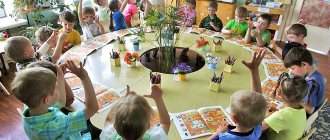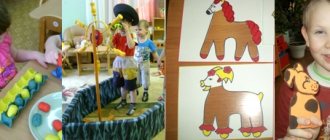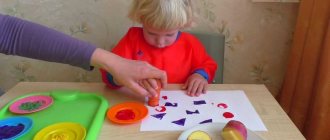All children in the world are united by a love of games.
Play is a natural need for a child, since it is in the form of play that children learn about the world, understand how it works, and consciously comprehend the experience gained.
Play is important not just as a source of joy and good mood, it develops the brain, imagination, creativity, vocabulary, social skills, the ability to learn and perceive more complex information.
How do 6-7 year old children develop?
At this age, the baby’s thinking abilities enter a new, better stage of development.
By age 6, most children:
- master reading, writing, counting to 20;
- understand the simplest time intervals;
- focus longer on one solution to one logical problem;
- their reasoning becomes more meaningful;
- understand information better by listening.
What games are useful at this age?
For a preschooler, different forms of games will be useful.
Psychologists recommend involving children in the following game formats:
- child-initiated play;
- play initiated by an adult;
- a traditional game when both a child and an adult can take the initiative.
From the point of view of benefits, the most significant games are those offered by adults, since in this case the child finds himself in a learning situation, gets acquainted with new words, concepts and can make this situation manageable.
As for choosing a specific game format, it all depends on the situation. For the street, outdoor games are selected that contain an element of sports. At home, you can play board games or role-playing games, or assemble a construction set.
1. Outdoor games develop coordination, strength, endurance, and reaction speed. At the age of 6-7 years, the game lasts about half an hour.
2. Board games help brighten up your leisure time when the weather is bad outside. With the help of cubes, puzzles, figures, cards, the child improves his skills - logic, spatial thinking, social interaction, speech, concentration, will.
There are a huge number of board games - walkers, puzzles, cubes, mosaics, construction sets, flashcards, strategies.
3. Educational games - in this case we are talking about the targeted development of a specific skill or ability, for example, speech, gross motor skills, intelligence, imagination.
The use of such games prepares fertile ground for the further development of the child’s creative abilities and talents. The training program is structured from simple to complex, but the conditions of each task should be slightly ahead of the child’s developmental level.
Didactic games for the younger group of kindergarten
At the age of 2-3, children actively get acquainted with the world around them and learn basic concepts. Didactic games for this age group are simple and involve one action. Group games are recommended; they teach kids to follow collective rules, develop communication and interaction skills to achieve goals.
Find a couple
For the game, prepare pictures of mittens and hats in 4 colors: green, red, yellow, blue.
Tell the children that the dolls are going for a walk. They have already put on their hats, but they can’t find mittens of the same color, they need help. Arrange the pictures chaotically on the table. The players' task is to find mittens that match the color of each hat.
Several people can play, each selecting their own 4 pairs. In this case, you can organize a competitive game: the first one to match all 4 pairs of mittens to the hats wins.
listen carefully
Give each student a flag. Play music or, if you are musically inclined, play an instrument. When the music is low, children should sit quietly with the flag down. And when the music starts playing loudly, the students raise a flag above their heads and wave it.
Make beads
For the game, prepare laces and beads of 4 colors: red, blue, green, yellow.
Tell the students that the dolls have gathered for the name day, but they have nothing to decorate themselves with. Offer to make beads, show the children laces and a box of colorful beads. The task is to select beads of a certain color from a box and attach them to a cord of a similar color.
The game can be competitive. 4 children play, each making beads of a given color. The one who finishes it faster than the rest becomes the winner.
Find your match
To play, make cardboard geometric shapes in different colors. Distribute the pieces in pairs according to the number of players.
Place the cards in a box and ask the children to take them out one at a time. Let the players look at the pieces, then find the same one from a friend. You can repeat the action many times. You can complicate it by dividing geometric shapes not only by color, but also by size.
Collect a picture
Prepare pictures for the game depicting objects familiar to preschoolers, cut them into 4 parts. Also place real objects in front of the children that match the pictures.
The players' task is to collect the picture. The player who completes the task correlates the resulting image with a real object. The winner is the one who first collects the picture and correctly points to the object corresponding to it.
Bad or good deed
Print out pictures with positive and negative stories for the game. Let the students look at the images and evaluate the actions of the characters. For example: “The boy pulled the girl’s pigtail. The girl began to cry. He did something bad."
Butterflies are flying
To play, cut out 5 butterflies from colored paper. Tie each one with a 50 cm thread. And secure the thread to a rope stretched horizontally. The distance between the figures should be approximately 40 cm, and their height should correspond to the eye level of the preschooler.
Tell them that butterflies fly beautifully. Blow on one of them, ask the students to do the same. Children take turns standing near the paper figures and blowing on them. The game is competitive, the one whose butterfly flies farthest wins. Make sure that players keep their back straight, do not tense their shoulders when exhaling, and do not puff out their cheeks. Each player exhales once, and it should last no more than 10 seconds, otherwise dizziness may begin.
Games 30. Plant
First of all, you need to make a plant - a tree, a flower - from any available materials. Then the child composes a fairy tale about him. The main thing is that in the story the child describes in detail how the plant feels - is it comfortable or is something bothering it.
Through these metaphors, an adult can understand what is bothering the child. If there is a cause for concern, ask your child what you can do to help the plant - build a fence, call a fairy, plant other trees. This way the baby will use the example of a fairy tale to cope with his anxieties.
Games 31. Face games
In children who have suffered some unpleasant events in life, a frozen mask may appear on their face and emotions disappear. You can motivate your child in several ways - invite him to play tricks, make funny faces with him, or organize a home theater.
Games 32. Simple holidays
Allow your baby to feel the holiday in your life as often as possible. Try to turn every simple event into something bright and unusual. For example, the festival of making the bed, washing, the festival of lunch. Be sure to record any of your child’s achievements, write them down or draw them - this motivates and builds confidence in yourself and your abilities.
Games 33. Color therapy
If your child often returns to unpleasant events in the past, focus his attention on the current day, for example, come up with a specific color for each day of the week and try to stick to it. For example, let Monday be blue - pick up such clothes, look for blue objects around.
Games 34. Schedule
To stabilize a child’s condition after a stressful situation, it is necessary to structure his daily routine, draw up a schedule, and decorate it. The kid must monitor its implementation. On the one hand, it teaches discipline, and on the other, it distracts from unpleasant thoughts.
Advice! Anxious children prone to stress intuitively choose outdoor games where they need to jump. This helps relieve tension and feel supported. Create an area for your child where he can jump safely and happily.
Conflict situations sometimes occur between children, and here play becomes critically important, since with its help the child relieves stress and relaxes . Of course, games should be appropriate for the child’s age and development, be diverse and useful. This is what we will talk about in our material.
Didactic games for the senior group of kindergarten
Didactic games, intended for preschoolers 5-6 years of age, involve the completion of complex tasks and the formation of correct relationships. In this age group, the educational and developmental process is built in the form of basic classes, and through games, children consolidate acquired knowledge and skills. The competitive process plays a significant role, promoting proper emotional development and establishing positive contact with other people.
Find the ball and name the color
Children stand in a circle. Stand in the center, throw the ball to each player in turn, and call a specific color. The player's task is to name the object with the appropriate color, then throw the ball back. For example: orange - orange, apricot, carrot. Or: purple - eggplant, plum, grapes, lilac.
Generalization
The players stand in a row. Throw a ball to each of them in turn, after naming a generalizing concept. Children must name objects that correspond to the generalization. For example: fruits - apple, orange, peach, pear, apricot, lemon.
Complete the drawing
To play, print out cards depicting shapes that can become part of an object. Laminate the images so that you can draw on them with erasable markers.
Show the children the cards and ask them what the shapes look like. Hand out the pictures to the players so that they can fill in what they represent. Then erase the images, change cards between players. And so on until each child has fantasized about all the figures.
Remember and find
The game should be organized in a spacious room in which kindergarteners can navigate well. Place any toys on the floor. Ask the player to look at them carefully and remember the location. Then blindfold the child with a scarf. The game task is to blindly find objects laid out on the floor.
Columbus egg
To play, print out the egg template, then cut along the lines into 10 shapes. From these figures you can create a variety of silhouette images. This activity is extremely fascinating for preschoolers and develops their imagination.
Who will collect the items faster?
The game is competitive. For her, prepare cards depicting objects that relate to different professions. For each player, or for a group of players if there are many children, determine a profession. The game's task is to find three pictures in a pile that relate to a given profession faster than others. For example: cook - cap, pan, ladle. Or: doctor - white coat, thermometer, syringe. Or: seamstress - thread, scissors, sewing machine. Or: builder - helmet, drill, trowel.
Complete the drawing
Give the players pictures of objects with missing parts, for example, a dog without a tail, a house without windows, a car without wheels. Children must say what is missing in the picture and complete this part.
Where to find time to play with your child
This question is asked by many parents, since modern moms and dads are busy people who have a lot of household responsibilities, work, of course, and a natural desire to take time for themselves and relax. Due to the fact that there is not enough time to spend with the baby, parents often worry and worry. Psychologists assure that you can find time to communicate with your child if you follow simple tips.
Tip 1 – play with your child and mind your own business at the same time.
Games that do not require special training or additional items can be played in the kitchen, bathroom, or on the street. If you don’t feel like playing, involve your child in homework, do something together, for example, make pizza, or just let your child help you.
The main thing is to talk to the child more, explain, praise and support.
Tip 2 – use any free minute.
Transport, queues, the road to somewhere - this time can be used profitably. Tell your child about natural phenomena, make riddles, compose fairy tales, play counting and words.
Tip 3 – games and activities should become a habit.
Of course, we are not talking about classes for an hour or two. Make it a rule to work with your child every day for 15-20 minutes; this will be quite enough for a child aged 6-7 years. For example, read a book to your child before bed.
Tip 4 – try to create a nurturing environment at home.
Use posters, manuals, cards, magnetic games. The more educational objects there are around a child, the faster he will remember information. Please note that developmental aids should be bright and colorful.
Tip 5 – find company for your child.
If this is the case and you cannot play with your baby, try to find children for him with whom he can spend his time.
Didactic games for the middle group of kindergarten
For preschoolers aged 3-4 years, didactic games are a way to expand their individual vocabulary and familiarize themselves with the objects of the surrounding world. Children learn the parameters and characteristics of objects, learn classification and comparison, and consolidate previously acquired knowledge.
When does this happen
For the game, prepare pictures with scenes from the daily life of a preschooler and place them in front of the students. When you say “morning,” children should look for images that correspond to that time of day, for example, brushing their teeth, doing exercises, combing their hair. Players who pick up the correct picture receive a point. The player with the most points wins.
Does this happen?
Say phrases relating to objects and phenomena of the seasons, and the students must say whether this happens. For example: “On a hot summer day, we left the house with a sled to go down the hill.” Or: “In the spring, birds began to gather in flocks to fly to the southern regions.”
What can you do in this place
Ask a question about a certain place, and the children must say what can be done there. For example: “On the river you can... swim, sunbathe, build sand castles, fish, ride a boat.” Or: “In the garden you can... weed the beds, water the plants, harvest the crops, set up a scarecrow.”
Name the signs
Say the words, and the children should take turns naming their signs. For example: a fox is red, cunning, beautiful, dexterous, tailed, fluffy. Or: the house is tall, brick, wooden, new, destroyed, spacious.
What does it sound like
For the game, prepare several boxes with different contents: sand, turf, grain, beans, pebbles. Demonstrate to the students what different substances sound like: shake each box. Then mix them up and, without showing the contents to the children, shake them again. Players must guess by the sound what substance is inside.
Shop
Organize an impromptu store, lay out various toys on the counter. Explain to children that they can buy a toy when they do not name it, but describe its features. Moreover, when describing, you cannot look at the item, so as not to give the seller a guess. The seller must, based on the signs presented, guess what kind of toy we are talking about and give it to the buyer. For example, a buyer says: “I need a round, bouncy, rubber toy.” The seller selects a ball.
Hide and seek
Organize a game on the kindergarten playground if there are a lot of trees and shrubs of different types. Or take your students to a city park.
Children choose who will search and hide behind trees and bushes. Your task is to guide the seeker, suggest where to look, without naming the type of plant. For example: “Find the one who hid behind a tall tree with a hollow and carved leaves.”
Name the action
Ask questions, and students must answer with verbs. The player who answers correctly receives a point. The one who collects the most points wins. For example: “What does the teacher do? - teaches a lesson, checks notebooks, educates, grades, writes on the board.” Or: “What can you do in the kitchen? “cook soup, peel potatoes, make tea, have lunch, wash dishes, bake pies.”
Intelligence of a child aged 6-7 years
At this age, children have already formed personalities and have their own views on the world around them and what is happening in it. The child understands his position both in the children's team and among adults, and accordingly builds a line of behavior and forms a certain attitude towards the people who surround him.
The level of emotional development in children 6-7 years old is also quite high. They show sympathy , empathize, feel the mood of other people, and offer help.
- We are talking about children who are almost first graders, they can control their mood, follow the instructions and requests of adults, and take part in group and individual activities.
Advice! Since children 6-7 years old easily navigate circumstances, parents can give their child the basics of personal safety and teach them to find a way out of difficult situations.
2. At 6-7 years old, children show an active interest in new knowledge, since at this age the memory capacity increases, the child’s attention becomes more concentrated, and the vocabulary expands (up to 6 thousand words).
3. Parents need to continue classes on the development of children’s speech, familiarize children with the structure of language, in addition, develop fine motor skills, logic, and the ability to systematize objects by characteristics.
Goals of didactic games in kindergarten
Didactic games contribute to the comprehensive development of a preschool child.
Their goals:
- formation of ideas about objects and phenomena of the surrounding world;
- consolidation of knowledge about flowers;
- familiarity with geometric objects;
- formation of ideas about right and wrong actions and actions;
- nurturing positive personal qualities, the ability to interact with others;
- familiarization with counting and numerical characteristics;
- development of memory, speech skills, concentration, ability to think logically;
- emotional and creative improvement, development of imagination;
- improvement of fine motor skills, general coordination and motor response;
- development of respiratory ability.








